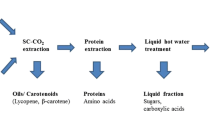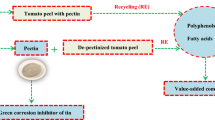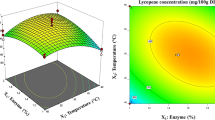Abstract
The present study focused on the full valorization of the tomato by-product, also known as tomato pomace consisting mainly of tomato peels and tomato seeds, by recovering natural antioxidants and edible oil, and subsequently reutilizing the leftover solid residues for the production of low-cost biosorbent. The tomato peel extract recovered using ethanol as food-grade solvent contained high phenol and flavonoid contents (199.35 ± 0.35-mg gallic acid equivalents (GAE)/g and 102.10 ± 0.03-mg quercetin equivalent (QE)/g, respectively). Even its lower content of lycopene (3.67 ± 0.04 mg/100 g), tomato peel extract showed potent antioxidant activity and can be therefore used as natural antioxidants either for food or cosmetic applications. High nutritional quality edible oil (17.15%) was extracted from tomato seeds and showed richness in unsaturated fatty acids (74.62%), with linoleic acid being the most abundant polyunsaturated fatty acid (49.70%). After recovery of these valuable compounds, the extraction solid leftovers were used to produce low-cost biosorbent tested for dye removal. Results showed that the highest biosorption yields were increasingly attributed to the acidic, direct, anthraquinone, then reactive dyes. Overall, the obtained results strongly support the complete utilization of tomato pomace for the recovery of valuable compounds and the sequential production of low-cost biosorbent.




Similar content being viewed by others
References
Abid Y, Azabou S, Jridi M, Khemakhem I, Bouaziz M, Attia H (2017) Storage stability of traditional Tunisian butter enriched with antioxidant extract from tomato processing by-products. Food Chem 233:476–482
Allison BJ, Simmons CV (2017) Valorization of tomato pomace by sequential lycopene extraction and anaerobic digestion. Biomass Bioenergy 105:331–341
AOAC (2000) Association of Official Analytical Chemists. Official methods of analysis, 17th ed. Washington
AOCS (1997) American Oil Chemists’ Society. Official and Recommended Practices of the AOCS, Champaign
Arco-Perez A, Ramos-Morales E, Yanez-Ruiz DR, Abecia L, Martin-Garcia AI (2017) Nutritive evaluation and milk quality of including of tomato or olive byproducts silages with sunflower oil in the diet of dairy goats. Anim Feed Sci Technol 232:57–70
Augustin MA, Sanguansri L, Fox EM, Cobiac L, Cole MB (2020) Recovery of wasted fruit and vegetables for improving sustainable diets. Trends Food Sci Tech 95:75–85
Azabou S, Abid Y, Sebii H, Felfoul I, Gargouri A, Attia H (2016) Potential of the solid-state fermentation of tomato by products by Fusarium solani pisi for enzymatic extraction of lycopene. LWT - Food Sci Technol 68:280–287
Azabou A, Ben Taheur F, Jridi M, Bouaziz M, Nasri M (2017) Discarded seeds from red pepper (Capsicum annum) processing industry as a sustainable source of high added-value compounds and edible oil. Environ Sci Pollut Res 24:22196–22203
Azabou Samia, Sebii Haïfa, Taheur Fadia Ben, Abid Yousra, Jridi Mourad, Nasri Moncef (2020) Phytochemical profile and antioxidant properties of tomato by-products as affected by extraction solvents and potential application in refined olive oils. Food Bioscience 36:100664
Bakić MT, Pedisić S, Zorić Z, Dragović-Uzelac V, Grassino AN (2019) Effect of microwave-assisted extraction on polyphenols recovery from tomato peel waste. Acta Chim Slov 66:367–377
Barka N, Abdennouri M, El Makhfouk M, Qourzal S (2013a) Biosorption characteristics of cadmium and lead onto eco-friendly dried cactus (Opuntia ficus indica) cladodes. J Environ Chem Eng 1:144–149
Barka N, Ouzaouit K, Abdennouri M, Makhfouk ME (2013b) Dried prickly pear cactus (Opuntia ficus indica) cladodes as a low-cost and eco-friendly biosorbent for dyes removal from aqueous solutions. J Taiwan Inst Chem Eng 44:52–60
Bersuder P, Hole M, Smith G (1998) Antioxidant from a heated histidine-glucose model system. I. Investigation of the antioxidant role of histidine and isolation of antioxidants by high performance liquid chromatography. J Am Oil Chem Soc 75:181–187
Biondi L, Luciano G, Cutello D, Natalello A, Mattioli S, Priolo A, Lanza M, Morbidini L, Gallo A, Valenti B (2020) Meat quality from pigs fed tomato processing waste. Meat Sci 159:107940
Butsat S, Siriamornpun S (2016) Effect of solvent types and extraction times on phenolic and flavonoid contents and antioxidant activity in leaf extracts of Amomum chinense C. Int Food Res J 23:180–187
CAC (1999) Codex standard for named vegetable oils, (http://wenku.baidu.com/view/966a07ffc8d376eeaeaa3167.html Accessed 02.07.14)
Chang C, Yang M, Wen H, Chern J (2002) Estimation of total flavonoid content in propolis by two complementary colorimetric methods. J Food Drug Anal 10:178–182
Cheikh-Rouhou S, Besbes S, Hentati B, Blecker C, Deroanne C, Attia H (2007) Nigella sativa L.: chemical composition and physicochemical characteristics of lipid fraction. Food Chem 101:673–680
Cicco N, Lanorte M, Paraggio M, Viggiano M (2009) A reproductible, rapid and inexpensive Folin-Ciocalteu micro-method in determining phenolic of plant methanol extract. Microchem J 91:107–110
Coelho M, Pereira R, Rodrigues AS, Teixeira JA, Pintado ME (2019) Extraction of tomato by-products’ bioactive compounds using ohmic technology. Food Bioprod Process 117:329–339
Elbadrawy E, Sello A (2016) Evaluation of nutritional value and antioxidant activity of tomato peel extracts. Arab J Chem 9:1010–1018
Giuffrè AM, Capocasale M (2016) n-Alkanes in tomato (Solanum lycopersicum L.) seed oil: the cultivar effect. Int Food Res J 23:979–985
Goula AM, Lazarides HN (2015) Integrated processes can turn industrial food waste into valuable food by-products and/or ingredients: the cases of olive mill and pomegranate wastes. J Food Eng 167:45–50
Grassino AN, Halambek J, Djaković S, Brnčić SR, Dent M, Grabarić Z (2016) Utilization of tomato peel waste from canning factory as a potential source for pectin production and application as tin corrosion inhibitor. Food Hydrocoll 52:265–274
Grassino AN, Djaković S, Bosiljkov T, Halambek J, Zorić Z, Dragović-Uzelac V, Petrović M, Brnčić SR (2019) Valorisation of tomato peel waste as a sustainable source for pectin, polyphenols and fatty acids recovery using sequential extraction. Waste Biomass Valori. https://doi.org/10.1007/s12649-019-00814-7
Gupta VK, Suhas (2009) Application of low-cost adsorbents for dye removal–a review. J Environ Manag 90:2313–2342
Heguy JM, Cassinerio CA, Fadel JG, Asmus J, Taylor SJ, De Peters EJ (2015) Nutrient composition and total-tract apparent digestibility of whole tomato seeds by sheep. PAS 31:462–466
Isik F, Topkaya C (2016) Effects of tomato pomace supplementation on chemical and nutritional properties of crackers. Ital J Food Sci 28:525–535
Juric S, Ferraric G, Velikov KP, Donsi F (2019) High-pressure homogenization treatment to recover bioactive compounds from tomato peels. J Food Eng 262:170–180
Kehili M, Choura S, Zammel A, Allouche N, Sayadi S (2018) Oxidative stability of refined olive and sunflower oils supplemented with lycopene-rich oleoresin from tomato peels industrial by-product, during accelerated shelf-life storage. Food Chem 246:295–304
Kehili M, Sayadi S, Frikha F, Zammel A, Allouche N (2019) Optimization of lycopene extraction from tomato peels industrial by-product using maceration in refined olive oil. Food Bioprod Process 117:321–328
Koleva II, Van Beek TA, Linssen JPH, Groot A, Evstatieva LN (2002) Screening of plant extracts for antioxidant activity: a comparative study on three testing methods. Phytochem Analysis 13:8–17
Kumar V, Surasani R, Kudre T, Ballari RV (2018) Recovery and characterization of proteins from pangas (Pangasius pangasius) processing waste obtained through pH shift processing. Environ Sci Pollut R 25:11987–11998
Li Y, Li Y, Zhang D, Li G, Lu J, Li S (2016) Solid state anaerobic co-digestion of tomato residues with dairy manure and corn stover for biogas production. Bioresour Technol 217:50–55
Lu Zhiqiang, Wang Jiajia, Gao Rui**, Ye Fayin, Zhao Guohua (2019) Sustainable valorisation of tomato pomace: A comprehensive review. Trends in Food Science & Technology 86:172–187
Luten J, Crews E, Flynn A, Van DP, Hurrell R, Deelstra H, Shen L, Fairweather-Talt S, Hickson K, Faire R, Schleminer U, Frochlich W (1996) Interlaboratory trial on the determination of the in vitro iron dialysability from food. J Sci Food Agric 72:415–424
Najafi H, Pajootan E, Ebrahimi A, Arami M (2016) The potential application of tomato seeds as low-cost industrial waste in the adsorption of organic dye molecules from colored effluents. Desalin Water Treat 57:15026–15036
Navarro-González I, García-Valverde V, García-Alonso J, Jesús Periago M (2011) Chemical profile, functional and antioxidant properties of tomato peel fiber. Food Res Int 44:1528–1535
Pataro G, Carullo D, Falcone M, Ferrari G (2020) Recovery of lycopene from industrially derived tomato processing by-products by pulsed electric fields-assisted extraction. Innov Food Sci Emerg 63:102369
Peláez-Cid AA, Velázquez-Ugalde I, Herrera-González AM, García-Serrano J (2013) Textile dyes removal from aqueous solution using Opuntia ficus-indica fruit waste as adsorbent and its characterization. J Environ Manag 130:90–97
Perea-Dominguez XP, Hernandez-Gastelum LZ, Olivas-Olguin HR, Espinosa-Alonso LG, Valdez-Morales M, Medina-Godoy S (2018) Phenolic composition of tomato varieties and an industrial tomato by-product: free, conjugated and bound phenolics and antioxidant activity. J Food Sci Technol 55:3453–3461
Prosky P, Asp NG, Schweizer TF, Devries JW, Furda I (1988) Determination of insoluble, soluble, and total dietary fiber in foods, food products: “interlaboratory study”. J Assoc Off Anal Chem 71:1017–1023
Savadkoohi S, Hoogenkamp H, Shamsi K, Fa A (2014) Color, sensory and textural attributes of beef frankfurter, beef ham and meat-free sausage containing tomato pomace. Meat Sci 97:410–418
Scaglia B, D’Incecco P, Squillace P, Dell’Orto M, De Nisi P, Pellegrino L, Botto A, Cavicchi C, Adani F (2020) Development of a tomato pomace biorefinery based on a CO2-supercritical extraction process for the production of a high value lycopene product, bioenergy and digestate. J Clea Prod 243:118650
Strati IF, Oreopoulou V (2011a) Process optimisation for recovery of carotenoids from tomato by-products. Food Chem 129:747–752
Strati IF, Oreopoulou V (2011b) Effect of extraction parameters on the carotenoid recovery from tomato waste. Int J Food Sci Technol 46:23–29
Szabo K, Cătoi AF, Vodnar DC (2018) Bioactive compounds extracted from tomato processing by-products as a source of valuable nutrients. Plant Foods Hum Nutr 73:268–277
Szabo K, Dulf FV, Diaconeasa Z, Vodnar DC (2019) Antimicrobial and antioxidant properties of tomato processing byproducts and their correlation with the biochemical composition. LWT - Food Sci Technol 116:108558
Toor RK, Savage GP (2005) Antioxidant activity in different fractions of tomatoes. Food Res Int 38:487–494
Yargic AS, Yarbay Sahin RZ, Ozbay N, Onal E (2015) Assessment of toxic copper (II) biosorption from aqueous solution by chemically-treated tomato waste. J Clean Prod 88:152–159
Yildirim A, Mavi A, Kara AA (2001) Determination of antioxidant and antimicrobial activities of Rumex crispus L. extracts. J Agric Food Chem 49:4083–4089
Yilmaz E, Aydeniz B, Guneser O, Arsunar E (2015) Sensory and physico-chemical properties of cold press-produced tomato (Lycopersicon esculentum L.) seed oils. J Am Oil Chem Soc 92:833–842
Acknowledgments
The authors would like to express their gratitude to Professor Slah Kammoun from the National Engineering School of Sfax for hel** in performing FT-IR spectra.
Author information
Authors and Affiliations
Corresponding author
Ethics declarations
Conflict of interest
The authors declare that they have no conflict of interest.
Additional information
Responsible editor: Lotfi Aleya
Publisher’s note
Springer Nature remains neutral with regard to jurisdictional claims in published maps and institutional affiliations.
Rights and permissions
About this article
Cite this article
Azabou, S., Louati, I., Ben Taheur, F. et al. Towards sustainable management of tomato pomace through the recovery of valuable compounds and sequential production of low-cost biosorbent. Environ Sci Pollut Res 27, 39402–39412 (2020). https://doi.org/10.1007/s11356-020-09835-5
Received:
Accepted:
Published:
Issue Date:
DOI: https://doi.org/10.1007/s11356-020-09835-5




